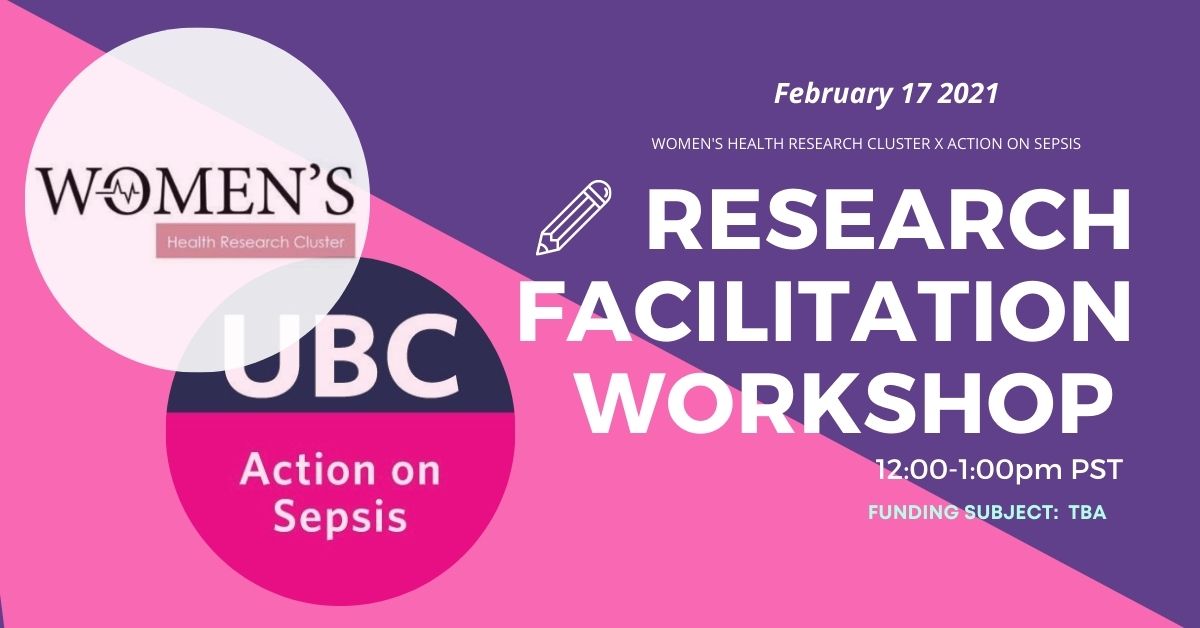Women's Health and Sepsis Research Facilitation Workshop
February 17, 2021, 12:00 pm to 1:00 pm

Action on Sepsis and the Women's Health Research Cluster are excited to host their second Research Facilitation Workshop on Feb 17th, 12:00-1:00pm PST.
These workshops aim to catalyze new research at the intersection of sepsis and women’s health and will serve as a place for you to discuss grants, share your research ideas, and meet multidisciplinary faculty and students that are interested in working on similar issues as you. Based on the survey responses, the CIHR 2021 Spring Project Grant will be this session's featured funding opportunity. This workshop will facilitate connection between attendees, brainstorming about new research projects at the nexus of women’s health and sepsis and review application details of CIHR’s Project Grant competition.
Workshop agenda:
1. Workshop introduction: what is women’s health and sepsis?
2. Icebreaker: what are your research interests, ideas, and goals?
3. Open discussion: identify areas of potential collaboration and/or new research project ideas
4. CIHR Spring 2021 grant overview
*Zoom information will be emailed before the workshop date.
What is women's health? What is sepsis?
Women’s health lies not only at the intersection of multiple medical disciplines (female-specific cancers, reproductive health) but also encompasses the humanities, social, applied and digital sciences (e.g. impact of child health on mothers health). Sex differences research also provides critical information about women’s health by answering questions about how and why females have higher prevalence of certain illnesses such as Alzheimer’s Disease, depression and autoimmune disorders.
Sepsis is defined as life-threatening organ dysfunction due to an infection. Any infection, (e.g., bacterial, protozoal, viral) can cause sepsis, and sepsis can occur in anyone. Sepsis can also arise as a complication of non-communicable diseases, including cancers. Sepsis is often the final disease progression of underlying medical conditions exacerbated by social determinants of health. Preventing and mitigating the burden of sepsis is not possible without understanding and addressing social and economic inequities. Furthermore, sepsis survivors often face long-term effects that persist following recovery from the initial condition, including neurocognitive impairment, functional disability, psychological deficits, and increased risk of death.
How do sepsis and women's health intersect?
Like women’s health, sepsis lies not only at the intersection of multiple medical disciplines (infectious diseases, nutrition, maternal, newborn and child health) but also encompasses the social, applied and digital sciences (e.g., education, economics, data science and mHealth). Postpartum mothers, newborns, and children are particularly vulnerable to and more likely to die from sepsis, especially those living in rural areas. Any infection that predmoinatntly impacts females, including hospital-acquired infections during delivery and urinary tract infections, can cause sepsis, and sepsis can occur in any woman. The long-term physical, congitive, and emotional impacts of sepsis can also lead to significant social and economic costs for women who suffer from or care for family members with post-sepsis syndrome. Increased awareness of and education and research on sepsis and post-sepsis syndrome, targeted towards vulnerable populations, is crucial to reduce the impact of sepsis. Sex differences research also provides critical information on gender-sepcific barriers to care, biological/immunological responses, and health outcomes.
Potential projects:
- Improve awareness of on sepsis among the public, including vulernable pregnant women, and education on sepsis for healthcare workers
- Dispel myths about vaccines to decrease vaccine hesitancy and increase vaccination rates among vulnerable populations (i.e., pregnant women, newborns & children and their caregivers)
- Implement nationwide sepsis screening tools for pregnant women;
- Identify and address gender-specific individual and systems-level barriers (including socioeconomic variables) to seeking and obtaining high-quality care;
- Reduce malnutrition among women, newborn, and children to avoid vulnerability to sepsis;
- Characterize gender-specific biomarkers that can be used to develop personalized diagnostics and therapies;
- Characterize the burden and epidemiology of post-sepsis syndrome (biological, cognitive, emotional) among women
- Assess current gaps in discharge education and care for sepsis patients and their families and develop tools and educational materials to support sepsis survivors (both for postpartum sepsis and for neonatal/pediatric sepsis, as women remain primary caregivers in many countries)